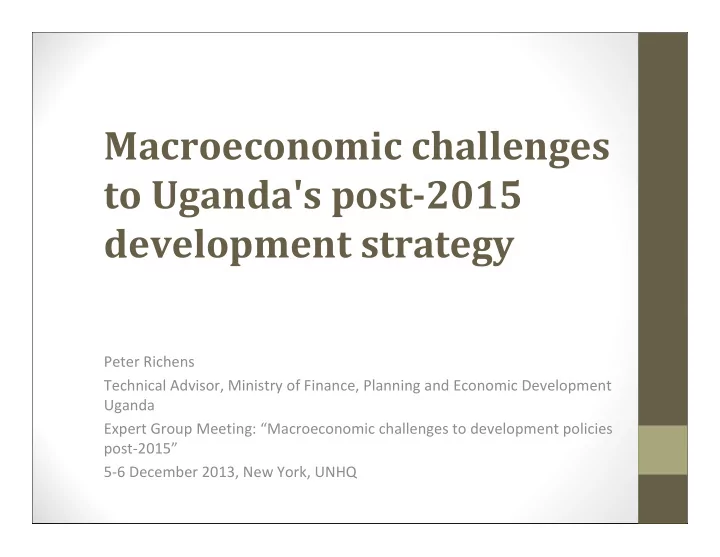

Macroeconomic challenges to Uganda's post 2015 development strategy Peter Richens Technical Advisor, Ministry of Finance, Planning and Economic Development Uganda Expert Group Meeting: “Macroeconomic challenges to development policies post ‐ 2015” 5 ‐ 6 December 2013, New York, UNHQ
Outline of the presentation 1. Background 2. Ugandan context 3. Fiscal policy Financing needs, options and tradeoffs 4. Sector and trade policy 5. External environment 6. Conclusions 2
1. Background • MAMS (Maquette for MDG Simulations) is well ‐ suited to development strategy analysis, and can take into account both economic and human development outcomes. • The model has been calibrated to the Ugandan economy and recently used to inform: • The Uganda MDG report for 2013 (thematic focus: Drivers of the MDGs and Uganda’s post ‐ 2015 development strategy). • Uganda’s long ‐ term fiscal strategy • This presentation synthesizes some of the lessons learnt. 3
2. Ugandan context • Strong growth record since 1990s, but recent slowdown. • Structural bottlenecks • Global volatility and weak external demand TFP growth, 1985 ‐ 2010 4 Source: Hassler et al. (2013)
National development agenda • Vision 2040 and six five ‐ year National Development Plans, first plan launched in 2010/11 • Frontload public infrastructure investment • Transport, oil refinery, renewable energy, water • Service delivery efficiency reforms • Support the productive sectors • Agricultural productivity • Value addition and trade • Encourage higher private savings and investment 5
Public resources • Tax revenue low even by African standards • Tax effort 12% to 13% of GDP over last decade, despite substantial improvements in tax administration • Tax policy reforms planned over next two years (streamline VAT and income tax exemptions) • Could generate up to 2% of GDP in additional tax revenue • A modest oil boom expected during 2020s • Production likely to start in 2018 • Public revenues likely to peak in 2025 at ~ 7% of GDP • Production will decline from 2030, revenue ~ 1% of GDP by 2040 • Structural decline in aid inflows • USD 300 million in budget support suspended in 2012/13 6
Grants and oil revenue, % of GDP 7
3. Fiscal policy • Financing infrastructure investment main challenge over medium term • Estimated infrastructure spending needs ~ 7% of GDP, compared to recent average ~ 4% of GDP. • Low public debt and prospect of oil revenues means that public investment can be financed sustainably. • Public debt (currently 30% of GDP) projected to peak in late 2010s between 40% and 50% of GDP • Expansion in deficit financing will need to be carefully managed • Public investment projected to increase GDP growth by around 0.5 percentage points per year. • Positive net impact on fiscal position over long term. • Significant acceleration in MDG progress, even without higher 8 spending in social sectors.
Allocation of public spending, % of GDP 9
Financing needs, % of GDP 10
Financing options and tradeoffs • Taxation • May reduce private investment and consumption in short term, but likely to be more than offset in long term • Main challenges governance ‐ related • Efficiency measures • Substantial progress made in some areas (energy subsidies) • Further gains not easy • Domestic borrowing • Risk of raising interest rates and crowding out private investment • Could be offset by positive spillovers for financial sector development • External financing • Exchange rate effects limited if used for import ‐ intensive investment projects 11 • Growth ‐ dampening effect if used for consumption or wages
Required non‐concessional external financing 12 Note: This assumes tax reforms are implemented successfully.
4. Sector and trade policy • Vision 2040 emphasizes targeted support for strategic sectors: • Industrial clusters and value chains • Creation and diffusion of new technologies • Regional integration to exploit growing markets and increase competition • Land reform • Productivity growth is projected to have a large impact on the MDG outcomes and to significantly reduce social and environmental pressures. • Particularly agricultural productivity 13
Sector policies and development outcomes Change in 2030 value relative to baseline scenario Agriculture TFP Manufacturing shock (2%) TFP shock (3%) On ‐ time primary school completion 2% 1% Under ‐ five mortality rate ‐ 11% ‐ 4% Maternal mortality ratio ‐ 9% ‐ 6% Access to safe water 2% 1% Access to sanitation 2% 1% Real GDP per capita 15% 7% Workers employed in agriculture ‐ 18% 4% Skilled unemployment rate ‐ 92% 5% Exports 14% ‐ 1% 14 Manufactured exports 32% 19%
5. External environment • External economic shocks could significantly slow Uganda’s economic and human development • Particularly shocks to agricultural productivity (climate change) • But Uganda’s optimal development strategy does not depend heavily on external economic conditions • Economic, fiscal and human development returns of public investment will remain high, and become even more needed in a low ‐ growth environment • Lower growth will make financing more difficult • Simulate a weakening in external demand: • A 30% reduction in world price of Uganda’s exports 15 • Estimated to reduce growth by 1 percentage point a year
Fiscal sustainability under low‐ growth conditions Net public debt, % of GDP 16
6. Conclusions • The tradeoffs between economic, fiscal, human development and environmental objectives are currently minor • Policy makers do not face a stark choice between economic growth, the MDGs, or the environment • Uganda’s post ‐ 2015 development strategy can accelerate economic growth, structural change and human development and simultaneously relieve environmental and social pressures 17
Conclusions, cont. • But implementation of this strategy faces a number of challenges: • Access to external finance • Fiscal ‐ monetary coordination • Conservative/short ‐ term mindsets • Budget credibility • Oil revenue management • Public ‐ private partnerships • Governance issues (tax, land reform) 18
Thank you
Recommend
More recommend